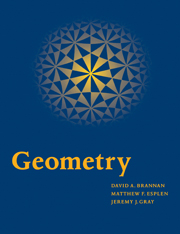Book contents
- Frontmatter
- Contents
- preface
- Introduction: Geometry and Geometries
- 1 Conics
- 2 Affine Geometry
- 3 Projective Geometry: Lines
- 4 Projective Geometry: conics
- 5 Inversive Geometry
- 6 Non-Euclidean Geometry
- 7 Spherical Geometry
- 8 The Kleinian View of Geometry
- Appendix 1 A Primer of Group Theory
- Appendix 2 A Primer of Vectors and Vector Spaces
- Appendix 3 Solutions to the Problems
- Index
2 - Affine Geometry
Published online by Cambridge University Press: 05 June 2012
- Frontmatter
- Contents
- preface
- Introduction: Geometry and Geometries
- 1 Conics
- 2 Affine Geometry
- 3 Projective Geometry: Lines
- 4 Projective Geometry: conics
- 5 Inversive Geometry
- 6 Non-Euclidean Geometry
- 7 Spherical Geometry
- 8 The Kleinian View of Geometry
- Appendix 1 A Primer of Group Theory
- Appendix 2 A Primer of Vectors and Vector Spaces
- Appendix 3 Solutions to the Problems
- Index
Summary
In Chapter 1 we studied conics in Euclidean geometry. In the rest of the book we prove a whole range of results about figures such as lines and conics, in geometries other than Euclidean geometry. In the process of doing this, we meet two particular features of our approach to geometry which may be new to you.
The first feature is the use of transformations in geometry to simplify problems and bring out their essential character. You may have met some of these transformations previously in courses on Group Theory or on Linear Algebra.
The second feature arises from the fact that the transformations we introduce form groups. Generally, we restrict our attention to geometry in the plane, ℝ2, but even in this familiar setting there may be more than one group of transformations at our disposal. This leads to the exciting new idea that there are many different geometries!
For example, we shall often use matrices to simplify our work.
Each geometry consists of a space, some properties possessed by figures in that space, and a group of transformations of the space that preserve these properties. For example, Euclidean plane geometry uses the space ℝ2, and is concerned with those properties of figures that depend on the notion of distance. The group associated with Euclidean geometry is the group of isometries of the plane.
This is because isometries of the plane preserve distances.
- Type
- Chapter
- Information
- Geometry , pp. 45 - 93Publisher: Cambridge University PressPrint publication year: 1999

